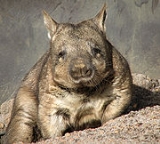
Lasiorhinus
Encyclopedia
Lasiorhinus is the genus containing the two hairy-nosed wombats, which are found in Australia
. The species are:
The Southern Hairy-nosed Wombat is found in some of the semi-arid to arid regions belt from New South Wales southwest to the South Australia-Western Australia border. The IUCN
categorises it as Least Concern
. Conversely, the Northern Hairy-nosed Wombat is categorised as Critically Endangered
and only survives in a 3 km² range within the Epping Forest National Park in Queensland, but formerly also existed in Victoria and New South Wales.
Australia
Australia , officially the Commonwealth of Australia, is a country in the Southern Hemisphere comprising the mainland of the Australian continent, the island of Tasmania, and numerous smaller islands in the Indian and Pacific Oceans. It is the world's sixth-largest country by total area...
. The species are:
- Northern Hairy-nosed WombatNorthern Hairy-nosed WombatThe Northern Hairy-nosed Wombat , also known as the Yaminon, is one of three species of wombats. It is one of the rarest large mammals in the world and is critically endangered...
, Lasiorhinus krefftii - Southern Hairy-nosed WombatSouthern Hairy-nosed WombatThe Southern Hairy-nosed Wombat is one of three species of wombats. It is found in scattered areas of semi-arid scrub and mallee from the eastern Nullarbor Plain to the New South Wales border area. It is the smallest of all three wombat species. The young often do not survive dry seasons...
, Lasiorhinus latifrons - Lasiorhinus angustioens fossil
The Southern Hairy-nosed Wombat is found in some of the semi-arid to arid regions belt from New South Wales southwest to the South Australia-Western Australia border. The IUCN
IUCN Red List
The IUCN Red List of Threatened Species , founded in 1963, is the world's most comprehensive inventory of the global conservation status of biological species. The International Union for Conservation of Nature is the world's main authority on the conservation status of species...
categorises it as Least Concern
Least Concern
Least Concern is an IUCN category assigned to extant taxon or lower taxa which have been evaluated but do not qualify for any other category. As such they do not qualify as threatened, Near Threatened, or Conservation Dependent...
. Conversely, the Northern Hairy-nosed Wombat is categorised as Critically Endangered
Critically Endangered
Critically Endangered is the highest risk category assigned by the IUCN Red List for wild species. Critically Endangered means that a species' numbers have decreased, or will decrease, by 80% within three generations....
and only survives in a 3 km² range within the Epping Forest National Park in Queensland, but formerly also existed in Victoria and New South Wales.

